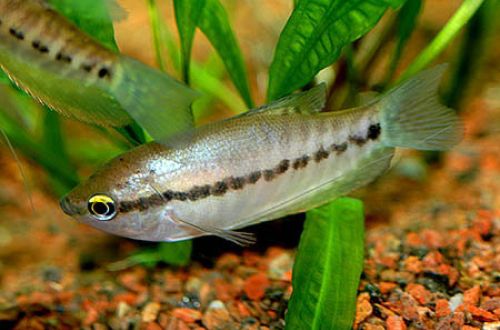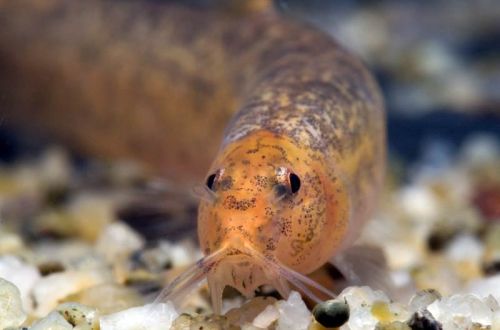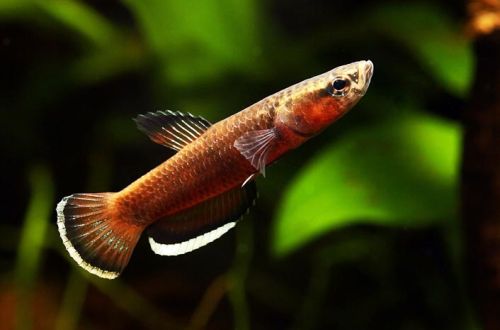
Snake Gourami
The snake gourami, scientific name Trichopodus pectoralis, belongs to the Osphronemidae family. Quite a large fish with an unusual color. The dotted nature of the pattern on the body and the predominant yellow-brown colors resemble snake skin, which is reflected in the name of the species. Unpretentiousness to living conditions and high endurance make it an excellent candidate for the role of the first fish.

Contents
Habitat
Snake gourami is widely distributed in the waters of Southeast Asia on the territory of such modern countries as Cambodia, Vietnam, Malaysia, in recent decades it was brought to the archipelagos – the Philippines, Indonesia, etc. Among the local population, this species is popular as food and is specially cultivated for this purpose .
In nature, these fish can be found in shallow ponds and swamps, in rice fields, they prefer shallow water bodies with a weak current and dense vegetation. During the wet season, they swim into the flooded forest canopy in search of food. They feed mainly on aquatic plants.
Description
The fish has an elongated oval shape, the body is somewhat compressed from the sides. It is distinguished by long pectoral fins, much larger than other gourami species. The ventral fins are filiform and extremely sensitive, with the help of which the fish explores the surrounding space.
In the process of evolution, representatives of this family have developed a special “labyrinth” organ, with the help of which fish can absorb oxygen directly from atmospheric air, swallowing bubbles from the surface of the water. This organ works in conjunction with the gills, is located in the oral region, looks like a small sac, penetrated by numerous capillaries, similar to a miniature labyrinth.
Body color varies from olive gray to light yellow. A horizontal dark dotted line is visible from the side, sometimes you can distinguish diagonal stripes that run along the entire body, reminiscent of the stripes on a zebra. In males, the edge of the ventral fin is colored orange or reddish.
Food
The home aquarium will accept all types of dry industrial and live food. An important condition is the mandatory inclusion of herbal supplements in the diet. The optimal diet is as follows – dry food, designed specifically for Gourami, mixed with vegetable plates, flakes (sold in the same way as regular food), bloodworms are served as a supplement two or three times a week. Feed once or twice a day, depending on the diet. If live food is added, then once, in other cases, feed twice a day.
Maintenance and care
Large fish will require a large spacious tank and productive equipment that can effectively deal with organic waste. Pay special attention to the filtration system. The filter should have a high capacity, but at the same time create as little water movement in the aquarium as possible, since a strong current will disturb fish that are used to stagnant or slightly flowing water. Other mandatory equipment consists of an aerator, a heater, and a lighting system set to dim light.
The design should use a large number of both root and floating plants, arranged in groups to leave free space for swimming. Equally important is the presence of shelters in the form of grottoes, snags, roots or artificial decorative objects (a sunken ship, a castle, amphoras, etc.). Dark soil is preferred, which favorably emphasizes the light color of the fish.
Social behavior
The most peaceful species among all Gourami, despite their size, they do not pose a threat even to small fish or fry. However, such peacefulness also has a downside, in no case can they be combined with active mobile species, and even more aggressive ones, in such a company the Snake Gourami will experience constant stress.
Sexual differences
The male is noticeably slimmer, has a pointed dorsal and anal fins, while those of the females are rounded. In addition, in males, the edges of the ventral fin are colored orange or red.
Breeding / breeding
Breeding is very simple and does not require much effort. Since the parents do not harm their offspring, spawning can be carried out in a common aquarium. However, if representatives of other species live together, then they can already pose a threat to eggs and gourami fry. It’s worth considering.
The incentive for spawning is the inclusion of meat products in the daily diet, as well as a gradual decrease in the water level in the aquarium to 20 cm during the week. Set the temperature within 28°C. After a while, the female will begin to fill with eggs, and the male will start building a nest from bubbles and pieces of plants. The nest, as a rule, is not large, located under the sheets of floating plants. After construction is completed, the courtship period begins. The male swims around the female, touches her with his fins, inviting her to the nest. When the pair is under it, the female releases several eggs, and the male fertilizes them, then the procedure is repeated. This species is very prolific, an adult female can release up to 5000 eggs.
Unlike other types of gourami, immediately after spawning, parents lose all interest in their offspring. Therefore, those eggs that did not fall into the nest will simply float on the surface of the water. Males of other types of “labyrinths” do not allow such indifference, they pick up all the eggs and transfer them to the nest, after which they remain to guard the clutch until the fry appear. However, they also tend to eat their own offspring, which the Snake Gourami would never do. Feed the fry with specialized microfeed, brine shrimp, ciliates.
Fish diseases
An extremely hardy species, in a tuned aquarium with a well-established biological system, health problems do not arise. Outbreaks of diseases can be caused by a significant deterioration in living conditions, poor nutrition, contact with sick fish. Read more about symptoms and treatments in the Aquarium Fish Diseases section.





